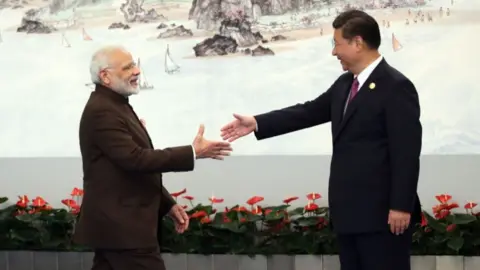India's Prime Minister Narendra Modi landed in China on Sunday with the sting of Donald Trump's US tariffs still top of mind.
Since Wednesday, tariffs on Indian goods bound for the US, like diamonds and prawns, now stand at 50%—which the US president says is punishment for Delhi's continued purchase of Russian oil.
Experts say the levies threaten to leave lasting bruises on India's vibrant export sector, and its ambitious growth targets.
China's Xi Jinping, too, is trying to revive a sluggish Chinese economy at a time when sky-high US tariffs threaten to derail his plans.
Against this backdrop, the leaders of the world's two most populous countries may both be looking for a reset in their relationship, which has previously been marked by mistrust, much of it driven by border disputes.
Put simply, what happens in this relationship matters to the rest of the world, Chietigj Bajpaee and Yu Jie of Chatham House wrote in a recent editorial.
India was never going to be the bulwark against China that the West (and the United States in particular) thought it was... Modi's China visit marks a potential turning point.
India and China are economic powerhouses—the world's fifth and second largest, respectively.
But with India's growth expected to remain above 6%, a $4tn (£3tn) economy, and a $5tn stock market, it is on the way to moving up to third place by 2028, according to the International Monetary Fund (IMF).
While the world has traditionally focused on the single most important bilateral relationship in the world, US and China, it is time we shift more focus on how the second and would-be third largest economies, China and India, can work together, says Qian Liu, founder and chief executive of Wusawa Advisory, based in Beijing.
The relationship is deeply challenging.
The two sides have an unresolved and long-standing territorial dispute—signifying a much broader rivalry.
Violence erupted across Ladakh's Galwan Valley in June 2020—the worst period of hostility between the two nations in over four decades.
The fallout was largely economic—a return of direct flights was taken off the table, visas and Chinese investments were put on hold leading to slower infrastructure projects, and India banned more than 200 Chinese apps, including TikTok.
Experts suggest that dialogue is essential to better manage the expectations of other powers who look to India-China as a key factor of Asia's broader stability.
There are other fault lines, including Tibet, the Dalai Lama, and water disputes over China's plans for a hydroelectric power project on a shared river, as well as tensions with Pakistan following recent attacks.
While Modi’s trip to China is pivotal, many see it as an uncomfortable alliance for both leaders.
The Shanghai Cooperation Organisation (SCO) that Modi attends aims to present an alternative worldview to that of the West, yet critics argue it has not yielded substantial outcomes historically.
As Modi works on strengthening ties within Asia, including plans for closer cooperation with ASEAN and Japan, the need for enhanced trade partnerships between India and China may become increasingly clear.
With both countries drawn closer by the challenges they face from the US tariffs, Modi's visit is aimed at repairing animosity and signaling to the world, especially Washington, that both countries have options.




















